8 B2B lead generation examples you should learn from
Getting new clients is hard. Discover over eight powerful B2B lead generation examples that you can use to win more clients in 2024.

Winning new clients gets harder and harder each year. As the barrier to entry to starting a business keeps decreasing, customer acquisition costs (CAC) keep going up. On top of that, the advent of data privacy regulations has hampered the precision of advertising targeting (and made attribution even more confusing than it already was).
However, just because the return on investment on paid ads is in flux, it doesn't mean that generating leads is impossible. In this article, we’ll go over 8 lead generation examples that real companies are currently using to help grow their customer base.
What are the keys to lead generation?
Apple and Google are killing the cookie. While more data privacy is a good thing overall, it has hurt the precision of digital marketing. Businesses no longer have access to a wealth of third-party data, which has greatly increased the role of first-party data in efficient targeting.
Considering all of this, it’s clear that the key to modern lead generation is getting customer data. Of course, it’s about more than just getting an email address. Capture the right data, and you’ll have the information you need to qualify each prospect, make more tailored and relevant pitches, and improve your conversion rates.
The other important thing to consider is that your lead generation content should be made with your target audience in mind. What’s valuable and relevant to the type of people who need your service or product can be quite specific. So, ensure you do plenty of research before committing to any of our lead generation examples below.
Finally, always consider where your content is leading to. That might be a landing page, a form, or a call to action imploring your prospect to reach out. Whatever it is, make sure your lead generation material aligns with your offer.
8 B2B lead generation examples and ideas
Without a steady stream of leads, you’ll never maximize your sales and revenue potential. But today is your lucky day because we have eight proven business-to-business (B2B) lead generation examples and ideas that can help you find, connect with, and qualify your target audience.
Here are eight B2B lead generation examples and ideas:
- Calculators
- Gated webinars
- Industry reports
- LinkedIn Lead Gen Forms
- Meta Lead Ads
- Newsletter subscriptions
- Free downloadable resources
- Personalized quizzes
Okay, let’s go over examples of each of these.
1. Calculators
Calculators are an excellent way to drive traffic to your site. The reason they work is one of the fundamental principles behind lead generation: an exchange of value. In short, if your calculator can help your users, they’ll be much more likely to part with their precious first-party data.
Of course, you can’t just slap up any old calculator on your site and sit back and watch the leads roll in. Instead, you need to do the sensible thing and implement a calculator that your target audience will actually use.
When it comes to the crunch, led gen calculators are about understanding your target audience and their pain points, and building something that makes their life that little bit easier.
Top tips for using calculators to land B2B clients
- Use your calculator form to collect information that helps you qualify leads, such as company size, position, budget, etc.
- Place your calculator prominently on your website, using prominent CTA buttons.
- Tie the calculation output to your offering and get that sales pipeline moving.
Example of B2B lead generation calculator
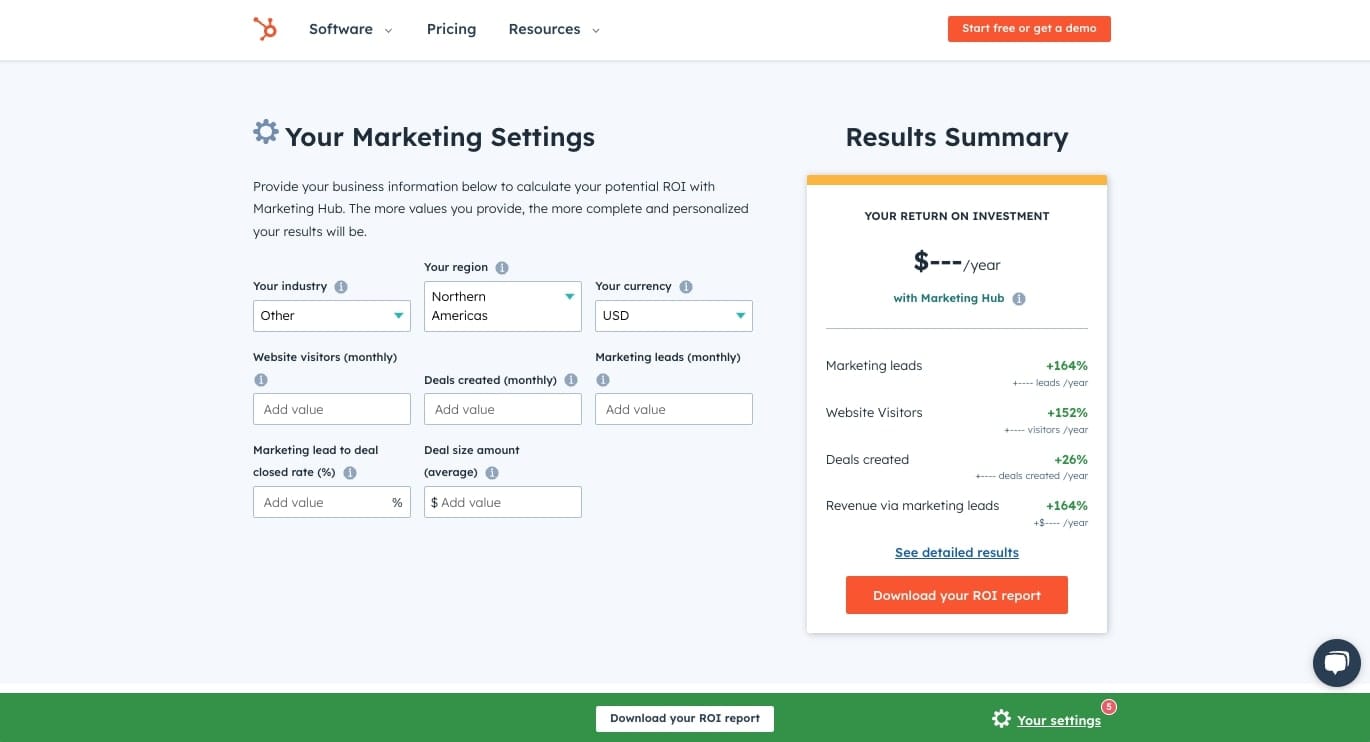
HubSpot is a huge name in the marketing and advertising space. They sell a wide range of products and services that help teams generate revenue. The HubSpot Marketing ROI calculator is one of the best lead generation examples to learn from because it is so efficient.
For starters, the calculator focuses on the ROI you can expect from using HubSpot’s products and services. In a way, it’s an advertisement for the brand. However, it also prompts users to enter lead scoring information, like their industry, web traffic, average deal size, and so on. Collecting this information allows HubSpot to prioritize leads and forgo a lot of time-consuming discovery.
2. Gated webinars
Webinars exploded during COVID lockdowns, and they aren’t going anywhere soon. They are a convenient and environmentally friendly alternative to seminars that double up as a solid way to underline your authority and expertise in a niche. They’re also a solid way to get leads for your B2B clients.
Again, gated webinars work because of the value exchange. Recipients sign up to learn something and network, while businesses get to use that data to close deals. The other thing to consider here is that attendees will typically align with your target audience, making them a great source of high-quality leads.
Another interesting fact about gated webinars is that you can also use them to nurture leads. This benefit is particularly relevant for high-ticket items with long sales cycles.
Overall, a webinar is a great way to establish your authority within your niche by delivering helpful, valuable information. Yes, keeping the content fresh and organizing and promoting these events takes a bit of work, but get it right, and you’ll have a steady stream of leads.
Top tips for using gated webinars to land B2B clients
- Choose topics that address your target audience’s pain points or business challenges.
- Create a simple signup form with minimal friction.
- Track things like registration, attendees, engagement, and conversions so you can optimize your webinars.
Example of B2B lead generation gated webinars
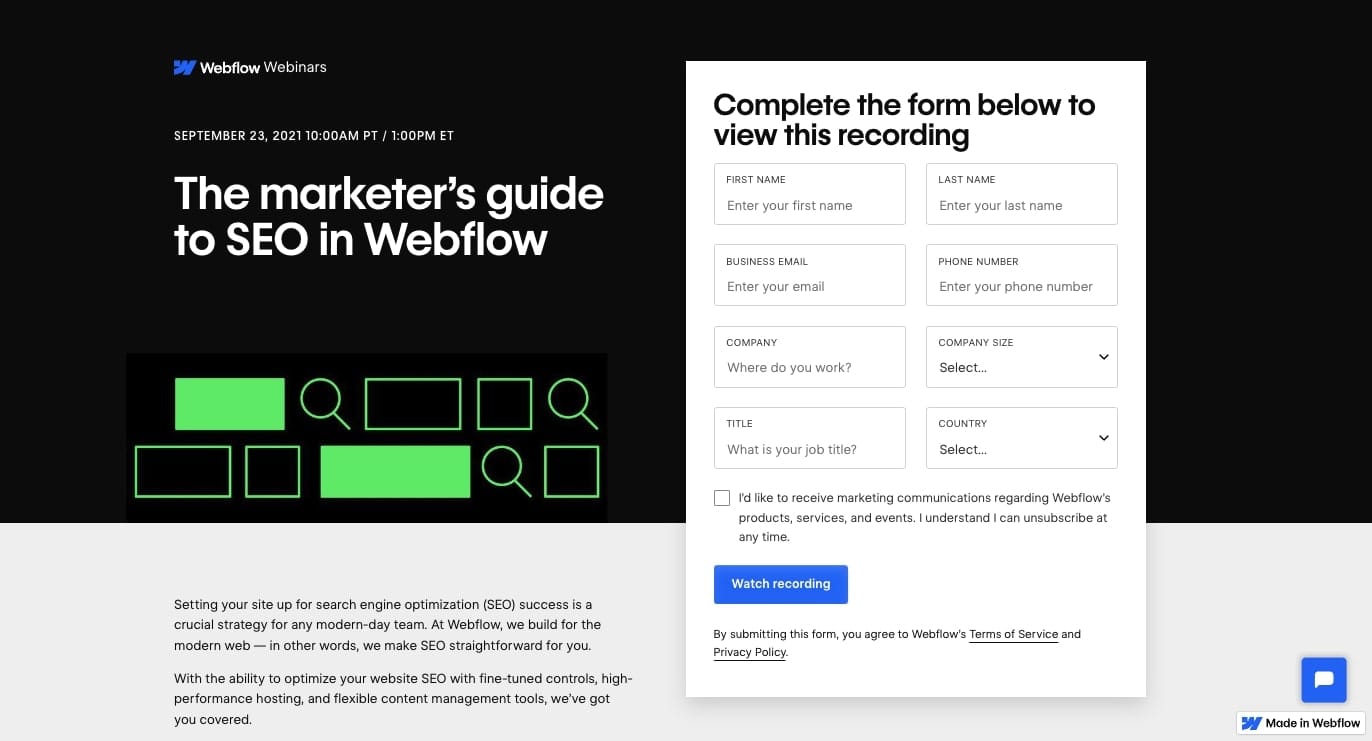
Webflow is a platform that helps businesses create visually striking custom websites. They produce a lot of great content, including webinars.
One of their webinars is an evergreen topic: how to do SEO for your Webflow-built website. The webinar is valuable for a number of reasons. Firstly, it addresses a clear pain point. Second, it’s intimately tied to Webflow’s offer. Third, it helps Webflow customers get more from their product, therefore boosting user retention. Finally, it also increases brand visibility.
3. Industry reports
In the race to generate great content, many companies completely overlook the goldmine they are sitting on: their own data. Having access to all this information means that you can produce excellent industry reports with hard data. When combined with your experience and expertise within a space, you can create highly valuable content for your industry.
Readers are always looking out for new and interesting information. Many businesses produce annual reports that offer analysis within their space or insights into the trends of the future. While many businesses will charge for these reports, you should make them free if you want to fill up your lead pipeline.
Overall, industry reports offer a lot of benefits. They help drive traffic to your site, position you or your brand as thought leaders, and help you gather data and nurture leads.
Top tips for using industry reports to land B2B clients
- Only permit business emails to sign up for the report so you have a good lead that you can qualify.
- Pick relevant and interesting topics, research them thoroughly, and present the report with lots of visuals to make them more readable.
- Ensure your report offers strategies, recommendations, or insights that help your prospects.
Example of B2B lead generation industry report
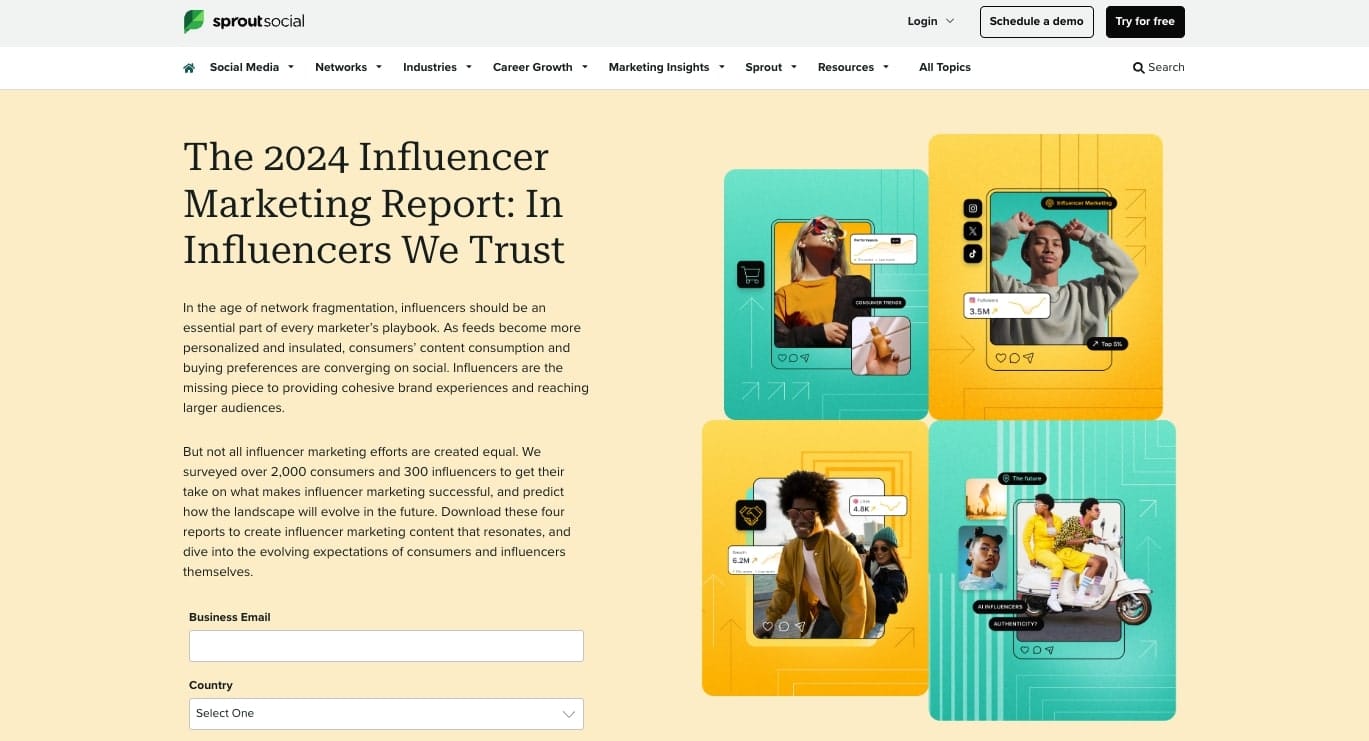
Sprout Social is a well-known social media management tool. The platform helps brands measure and understand the impact of their social media marketing. They produce annual reports on a wide range of topics that are relevant to their audience.
For example, their 2024 Influencer Marketing Report discusses the tech, trends, and consumer preferences that will impact the space this year. It’s essential reading for anyone who is interested in influencer marketing, which tightly aligns with Sprout Social’s ideal customer.
4. LinkedIn Lead Gen Forms
If you’re in B2B sales, LinkedIn is the place to be. Sure, LinkedIn is a strange and crowded place where it feels like everyone is in permanent TED Talk mode, but it has the highest concentration of decision-makers of any platform, which is really all you need to know.
Another thing about LinkedIn is that the company is obsessed with keeping users on the platform. However, LinkedIn Lead Gen Forms are a happy compromise. When users click an ad, instead of being directed to your landing page, they can fill out a form. Most notably, their details auto-populate, which removes a point of friction and increases conversion rates.
Top tips for using LinkedIn Lead Gen Forms to land B2B clients
- Use a mix of open and close-ended questions to get the customer data you need.
- LinkedIn Lead Gen Forms are a great way to promote other lead magnets, like reports or newsletters.
- Use LinkedIn’s ad targeting to show your ads to specific job titles, industries, or company sizes.
Example of LinkedIn Lead Gen Forms
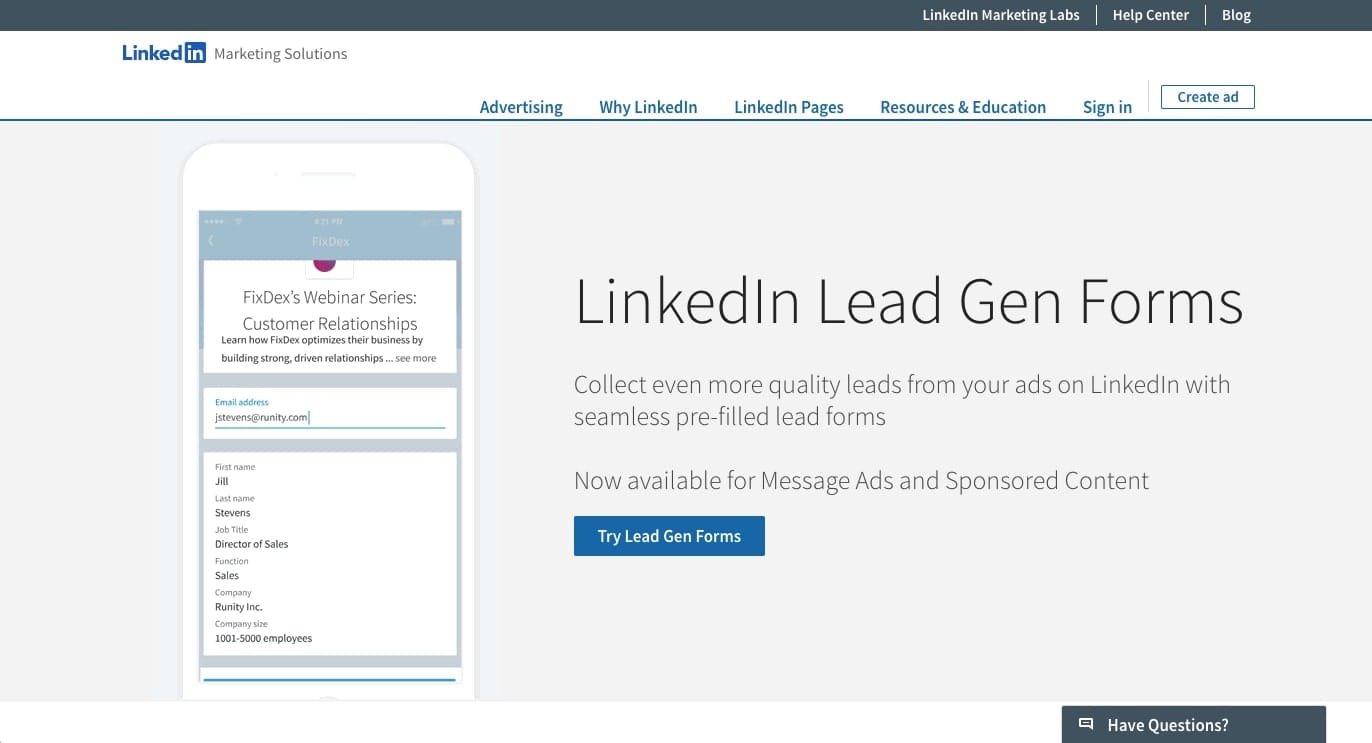
You can add LinkedIn Lead Gen Forms to Sponsored Posts or Message Ads. The campaigns are simple to create and run, and if you get your targeting right, you’ll have a nice stream of interested parties to follow up with.
5. Meta Lead Ads
You might be familiar with Meta Lead Ads under their former name, Facebook Lead Ads. This lead generation technique works similarly to their LinkedIn equivalent from above. However, the ads are shown on Meta and Instagram.
When your ads are shown on Meta properties, customers can click the ad, and it will auto-populate with their information. Again, this time-saving feature takes advantage of the fact that Meta already has customer information, meaning all you need to do is focus on the quality of your ads.
Top tips for using Meta Lead Ads to land B2B clients
- Make your value proposition and benefits crystal clear in your Meta Ads to boost click-through rates.
- Make use of visuals to catch your prospect's eye as they scroll their news feed.
- Lookalike audiences are a great way to connect with prospects.
Example of Meta Lead Ads

Meta Lead Ads are a fast and convenient way to produce targeted leads based on interest in your ads. The success of the endeavor hinges on the quality of your ads and your targeting, but if you get your creatives right, it’s a powerful way to connect with potential customers.
6. Newsletter subscriptions
Newsletter subscriptions are a mainstay of digital marketing, and for good reason. Despite the wealth of other options, email marketing is still the most cost-effective and high-ROI outreach method. Newsletters are one of the best ways to get potential clients' emails and slowly build a relationship.
The thing with newsletters is that they are a lot of work. You need to produce great content consistently if you want to sustain high open rates. However, they’re a great way to showcase your expertise and nurture leads because they give you a direct line of communication with your list.
If you go down the newsletter route, you have a lot of freedom to write different types of content. It could be industry news, curated stories, how-to guides, tips and tricks, or anything that will resonate with your audience. Keep your output bright, punchy, and helpful, and your list will grow steadily.
Top tips for using newsletter subscriptions to land B2B clients
- Where possible, segment your email list so each recipient only receives relevant communication.
- Use other lead magnets to gain subscribers. For example, when a prospect signs up for your webinar or industry report, put them on your mailing list with permission.
- Follow email deliverability guidelines to make sure you stay out of your prospect's spam folder.
Example of newsletter subscriptions
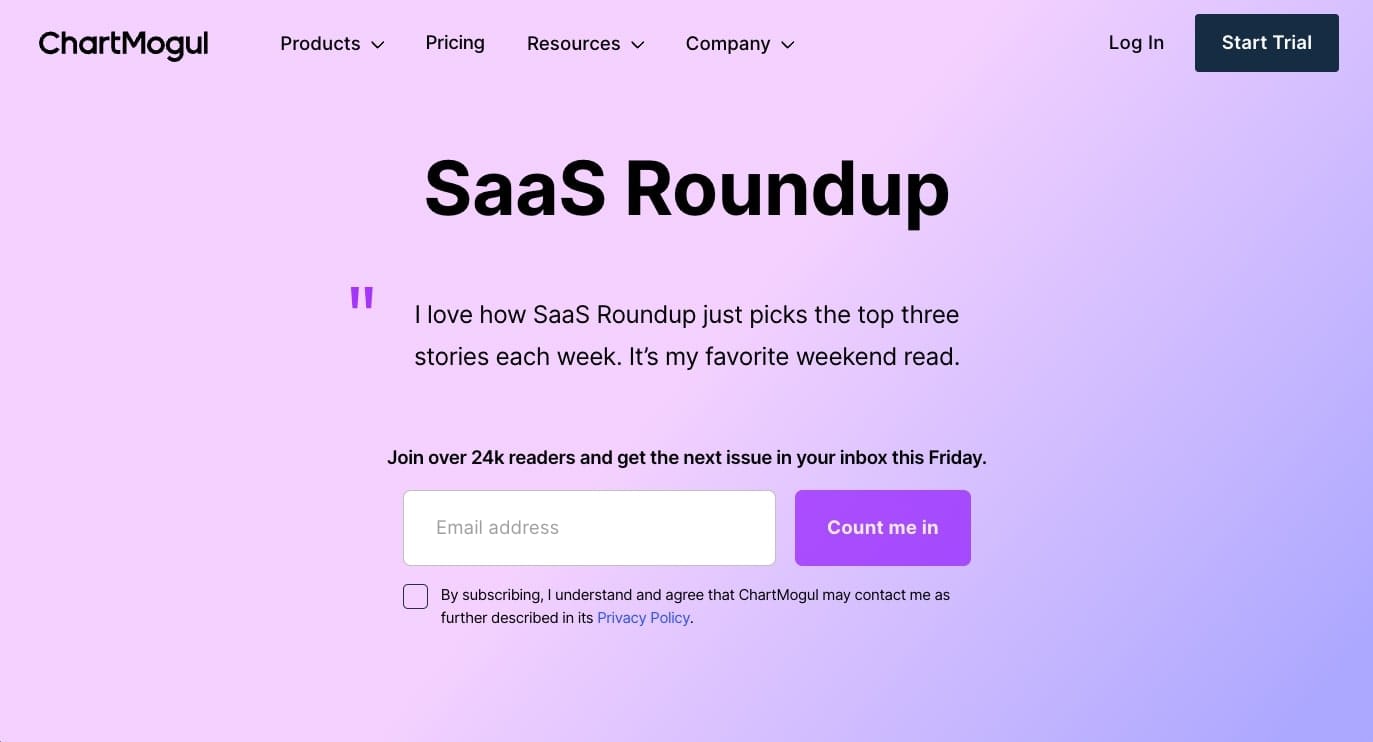
There are lots of great lead-generation newsletters out there, but ChartMogul’s SaaS roundup is one of the best out there. The team curates some of the biggest and most interesting stories in the software space each week, ensuring you stay in the loop.
Aside from making a great CRM platform, ChartMogul produces a wide variety of checklists, reports, and templates that can help your business. Their content game is on point, targeted toward their ideal customer, and most importantly, super valuable.
7. Free downloadable resources
Free downloadable resources are a broad church. The concept covers anything like eBooks, whitepapers, templates, checklists, and mini-courses. Once more, the key is understanding your prospect’s pain points and designing content that will help them solve their issues.
The benefits of offering these free resources include establishing credibility and authority for your brand and developing relationships with prospects by helping them improve their situation. Obviously, the quality and relevance of your resources will determine how many leads you generate. However, with the right promotion and a strong landing page, this approach can really reap dividends.
Top tips for using free downloadable resources to land B2B clients
- Segment your prospects by targeting them with different types of resources.
- If you want to stand out, you need to dig deep and offer your audience something they can’t find elsewhere for free. So, put the work in.
- Downloadable resources are a great way to repurpose existing content. However, keep things fresh and put a new spin on the resources.
Example of free downloadable resource
Gloss Genius is an app that helps beauty salons and cosmetic freelancers book clients and grow their businesses. Their site offers users a salon marketing checklist that aligns perfectly with their target audience’s growth mindset.
8. Personalized quizzes
Personalized quizzes are a fun and engaging way to collect first-party data and pre-qualify leads. If you put enough thought into the content, it can be a great starting point for your relationship with your audience.
The key here is to use the questions to find out more about your prospects. In particular, you should find out things about their job role, company size, and, where possible, the problems that they have that your product or service can solve.
A well-constructed quiz can really take the pain out of discovery and leave a good impression on your target audience.
Top tips for using free downloadable resources to land B2B clients
- Each quiz should have a clear objective in mind, whether that’s collecting data, promoting a product, qualifying leads, or educating your audience.
- Make your questions as interesting and compelling as you can. Additionally, mix things up between Likert scales, multiple choice, and a few open-ended questions.
- Use the results of the test to offer personalized recommendations, advice, or insights to your audience.
Example of free downloadable resources

Brittany Berger’s Which Pop Star Will Save Your Content Strategy? Quiz is a shining example of how to do lead generation in a lighthearted way. By focusing on pop stars, potential clients are engaged enough to barely notice that they are offering up key information that helps qualify them as a lead and communicate where they need help with their content.
Sure, this specific approach won’t work for every industry, but everyone can learn something from this excellent quiz.
Conclusion
As you can see from our lead generation examples, there are lots of different ways that you can engage prospects and get the vital first-party data you need to nurture them as leads or retarget them with paid ads.
While Assembly can’t produce the content for you, it can help you with the most important part of the process: building forms and getting the data into your CRM. From there, you can send the proposals and contracts you need to boost your revenue. So, sign up for a 14-day trial today to get the final piece of your lead generation puzzle.

